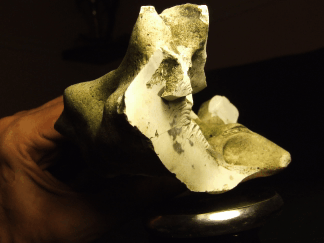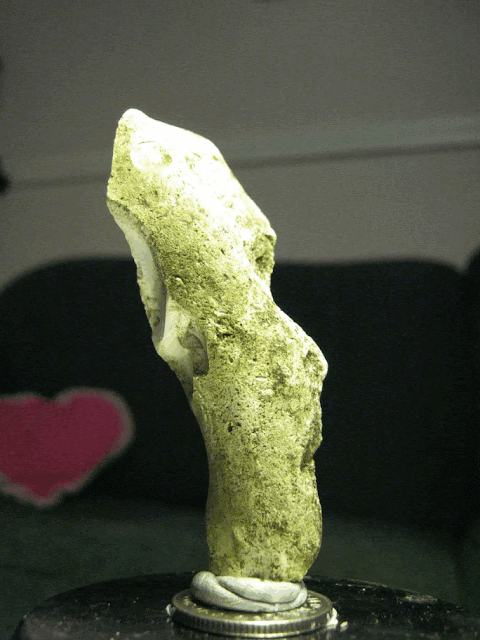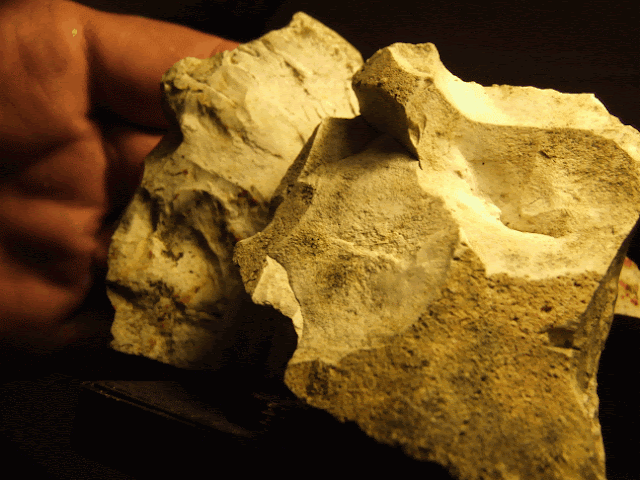Thursday 19 December 2013
Sunday 1 December 2013
Tuesday 19 November 2013
Thursday 29 August 2013
Paleo Bird Effigies
This afternoon I received a copy of, Field Guide, Finding and Identifying The North American Indian Stone Bird Effigy. by Dennis J. Moore. ISBN 978-0-578-06622-6
I'm unable to bring you a proper review of this book, but what I will give you are some first impressions and insights into the publication.
'The North American Indian Stone Bird effigy is an artifact directly associated with ancient tree burials. Tree and platform burials are mankind's oldest and most widespread way of dealing with a body after death.
The mysterious ritual practice of making and using a stone 'bird effigy' at funerals and cemeteries appeared fully developed in Michigan over 13,000 years ago by people moving north after the last Ice Age.'
From the back cover of the book.
A weighty soft cover volume, almost 200 pages, full of glossy high quality photos of single artifacts and lithic groupings. Instantly recognisable topologies and comparisons of suspected artifacts and lithic collections flow from page to page.
At fist glance who could possibly argue with such a detailed study into the origins of these artifacts, and who should doubt Mr Moore for his ability, recognition of sites, and for detailing this archeological evidence, for us all too see.
Let me tell you why at first visual appraisal I have no reasons to doubt the validity of Dennis Moore's study. Almost every page brings to me recognisable shape form topology, glyph content and visible agency. I am in no way condoning every lith in the book as a genuine artifact, what I am saying is I see a lot of very convincing images of artifacts in his book.
Trying not to be unfair to Dennis, his book and artifacts, I feel it a testimony that he has managed to produce such a detailed volume, without having access to what I consider to be a better selection of such things, that is unfair as such as location and culture discoveries of Dennis are not within his control, saying that this is by far the most complete topology of lithic discoveries from any archeological site I have ever seen, the academics would do well to follow in his footsteps.
My publication, if ever published, will have quite a name to live up to if ever to be compared.
To find out more, Go visit Dennis's website Paleo Bird Effigies.
USA @ Revelation in Stone.
Below, one of my own iconographic lithic finds.
I'm unable to bring you a proper review of this book, but what I will give you are some first impressions and insights into the publication.
'The North American Indian Stone Bird effigy is an artifact directly associated with ancient tree burials. Tree and platform burials are mankind's oldest and most widespread way of dealing with a body after death.
The mysterious ritual practice of making and using a stone 'bird effigy' at funerals and cemeteries appeared fully developed in Michigan over 13,000 years ago by people moving north after the last Ice Age.'
From the back cover of the book.
A weighty soft cover volume, almost 200 pages, full of glossy high quality photos of single artifacts and lithic groupings. Instantly recognisable topologies and comparisons of suspected artifacts and lithic collections flow from page to page.
At fist glance who could possibly argue with such a detailed study into the origins of these artifacts, and who should doubt Mr Moore for his ability, recognition of sites, and for detailing this archeological evidence, for us all too see.
Let me tell you why at first visual appraisal I have no reasons to doubt the validity of Dennis Moore's study. Almost every page brings to me recognisable shape form topology, glyph content and visible agency. I am in no way condoning every lith in the book as a genuine artifact, what I am saying is I see a lot of very convincing images of artifacts in his book.
Trying not to be unfair to Dennis, his book and artifacts, I feel it a testimony that he has managed to produce such a detailed volume, without having access to what I consider to be a better selection of such things, that is unfair as such as location and culture discoveries of Dennis are not within his control, saying that this is by far the most complete topology of lithic discoveries from any archeological site I have ever seen, the academics would do well to follow in his footsteps.
My publication, if ever published, will have quite a name to live up to if ever to be compared.
To find out more, Go visit Dennis's website Paleo Bird Effigies.
USA @ Revelation in Stone.
Below, one of my own iconographic lithic finds.
Monday 26 August 2013
American Paleoart Update.
I just received this from our mystery American collector, and felt I should post it right away.
Quite why and how our mystery man came to find this stone is still a mystery to me. But I have noticed our American friend has a skill for recognising the obvious artifacts, as well as the less so obvious, more importantly.
This is a bit of a testimony really, as our American mystery man has been finding suspected artifacts, but was unaware of some of the common motifs.
Looking back through his suspected worked materials, only then did he discover motifs I had suggested to him.
It is worth pointing out, that as far as I am aware America has no fossil record for elephants or gorillas. Mastodons it has got though.
Yet here is a stone that seems obviously to be an artifact through iconography alone.
This American rock art find shows an elephants head, looking straight at us, possible pan type gorilla facing right, and another face on the left ear. It is easy to see symmetry in the two faces. This would be a configuration seen in my own British finds, gorilla and elephant are possibly the strongest motifs I have revealed yet, but be warned, I have much to add to the study of #paleolithic #art.
Sunday 25 August 2013
American Paleoart
American Paleoart, is there such a thing?, well contrary to popular beliefs, yes there is!
I'm always meeting new and wonderful people in my research into prehistoric flint tools and figure stones. Recently an American collector contacted me, explaining how he liked my website and enjoyed its content.
The chap was honest and straight forward, and I enjoy those traits in people. So we were set to get on well, from the start.I passed on a few hints and tips, in photography, and a few of the paleoart secrets I have discovered.
The next thing I know, photo after photo of suspected Paleoart and flint tools are arriving in my inbox!
The poor guy is in shock! He cannot believe what he is seeing! and nor can I!
Was there a global common culture, pre-anything most American establishment archaeologists dare mention?
Was there a global common culture, pre-anything most American establishment archaeologists dare mention?
Can this be true? intercontinental continuity between an undocumented prehistoric visual language? Man in America long before most would claim?
Yes, from what I've seen so far undoubtedly there are motif and symbolic similarities between euro and American lithic finds. Although I have not seen the collectors artifacts in person, I have no reason to doubt there validity.
In the next few weeks we will be compiling a post of this as yet nameless mystery man, detailing his American finds and analysing there suspected iconography's.
#USA @ Revelation in Stone.
#USA @ Revelation in Stone.
Wednesday 21 August 2013
Natural Selection
It is worth mentioning selectiveness when looking for prehistoric artifacts, what we perceive to be an artifact, why we pick up certain stones, and why we discount others. We should not be so fast to throw stones with possible modification over our shoulders, just because they don't fit a preconceived idea of what a #prehistoric artifact should look like. Likewise we should not discount stones that show little or no modification.
It is actually bad practice, to pick up any suspected artifact without first considering responsibility for its recording, and note in memorable history. When we take stones home with us we are indeed taking something possibly quite significant away from the site and our understanding of it as a whole. This is not always the case, surface finds and unstratified materials can give us clues about new sites, but only if people get to know about the finds themselves and where they were found.
That said, if everyone left the stones in the field, nobody would learn much of anything about these stones, and the culture, or prehistoric landscape they come from.
It is also worth noting the vast veriety in #lithic implements, and the fact that you should not be selective in noting what items your site provides. This is important, so artifacts are best seen as a complete collection, across every suspected relevant item, not just those perfect hand axes, but the other things that can be found repeatedly at the site of #archeological interest. This will give a broader view of any suspected relevant #culture attached with the finds.
The photos below are some finds from my site, these were found alongside some of my more obvious artifacts. These stones are entirely natural in form or appear to have very little obvious modification, if any.
The spherical objects I presume have been collected by peoples in the prehistoric era, no doubt there are many sugestable uses for such things. The objects formed naturally underground and were obviously prized when found, if indeed linkable to the culture concerning the creation of some of the more complex #polymorphic #art. It is really without saying, that the presence of these almost perfect ball shape stones, in concentration at my site, is indicative of the presence of some kind of historical/prehistorical culture.
The other stones I also believed to hold some significance, natural #elephant head and #seal shapes in stone found next to more obviously worked atifacts holding the same set of suspected #symbology.
Monday 19 August 2013
Ancient Stone Face Effigy.
This flint pebble has a simple face description, much like the worlds #oldest known #art object, at approximately 3 million years old. However unlike that object, this one seems to offer some good signs of modification, and bares red ochre markings, authenticating its provodence. #ancient #effigy
From Eoliths @ Revelation in Stone.
From Eoliths @ Revelation in Stone.
Saturday 17 August 2013
Prehistoric flint tools.
These two artifacts were found in close proximity, a beautiful blade scraper tool, and what I describe as a shaving razor with grooming utensils. The scraper may lack any true iconography?, but still a beautiful artwork. The razor blade holds some easy to see paleolithic glyphs, seal, elephant head and gorilla head. From Revelation in Stone.
Thursday 15 August 2013
Anamorphic art, Animation and Poly Glyphs.
This artifact is from my usual site. It's complex natural form has been exploited to carry many prehistoric icons.
In the animation I suspected ape with arm, looking away from us, to the right. The conveniently placed eye of a good stag or dear head impression is on the cortex, bottom right.
This stone holds much more, two suspected elephant types, animated flapping bird, a profile of a man eating, animated, to name only a few. I will have to provide a full write up on this artifact at some point. Brett.
Tuesday 13 August 2013
Why my prehistoric artifacts are genuine.
Why do I make such claims about my stone finds?
The majority of the polymorphic Artifacts come from one small area of Hampshire, they are prolific at the site, so much so that almost every stone visible at the site is either a prehistoric tool or one of these poly glyph artifacts.
But they are just stone's?
Yes, but modification is very visible in many of the artifacts. Nature can produce similar shapes in flint nodules, but these would be cortex covered. I have some of these more natural examples from my site, these may have been used in the same way, under the circumstances of the site its not difficult to see why, I see no problem with prehistoric man taking advantage of a rare natural phenomena. That is indeed why I'm able to find them.
But your just seeing these shapes, like in clouds?
We have this ability to see faces in clouds, and other things. Naturally our prehistoric ancestors would of had that same ability too. My stones carry common motifs across many examples, I can repeat shapes and motifs in my artifacts time and again, and show good comparisons. The shape and form of my artifacts show common topologies, and repeat content, and association by location, nature cannot do this.
These examples are very similar in shape and suspected glyphs, show me where nature brings 3 clouds together same place same day, that all look the same and all have multiple iconography. Surely nobody will claim they can? :-)
Friday 9 August 2013
Crouching Hominin Hidden Elephant!
This flint artifact was found on my usual hunting ground. This animation shows an almost full artistic impression of a hominin. As always many common glyphs can be extracted from this paleolithic artwork, including the ubiquitous elephant head icon. More neanderthal images can be seen at my website.
Suspected Hominin and Neanderthal face sculpture.
These two prehistoric flint artifacts were found in very close proximity, both have other recognized paleolithic symbolic and iconographic images in them. I have set them up in the animation to show a comparison of these suspected hominin or Neanderthal face sculpture's. Find more paleolithic art at Revelation in Stone.
Polymorph with crystal inclusion.
This complex paleolithic artifact has many common motifs.
Simple iconography repeated through my own collection is easy to perceive. Other prehistoric art investigators have found artifacts that closely resemble this fine example. Although a very skilled work of art, by any standards, art is not the purpose of this beautiful stone.
Simple iconography repeated through my own collection is easy to perceive. Other prehistoric art investigators have found artifacts that closely resemble this fine example. Although a very skilled work of art, by any standards, art is not the purpose of this beautiful stone.
Subtle ape face flint sculpture.
Britain's oldest identifiable art?
A very brilliant example of #paleolithic stone #sculpture, and representation, A very well defined #elephants head.This stone holds other motifs such as the bird, ape face, and suspected #hominid faces. This flint shows an interesting pattern of cortex removal chips, a very rare and effective flint sculpture technique used by people of the paleolithic. The basic outlying shape of this artifact is repeated in many of my #paleoart finds. I will demonstrate this as the blog progress's, effectively proving a completely new flint tool topology and type, that visually communicates iconographic 'words' used as a #prehistoric communication tool.
Wednesday 7 August 2013
Revelation in Stone, flint tool and prehistoric art blog.
I have created this blog to keep people updated on my stone age flint tools and prehistoric art finds.
I will post pictures of flint tools as well as figure stones.
Subscribe to:
Posts (Atom)






























